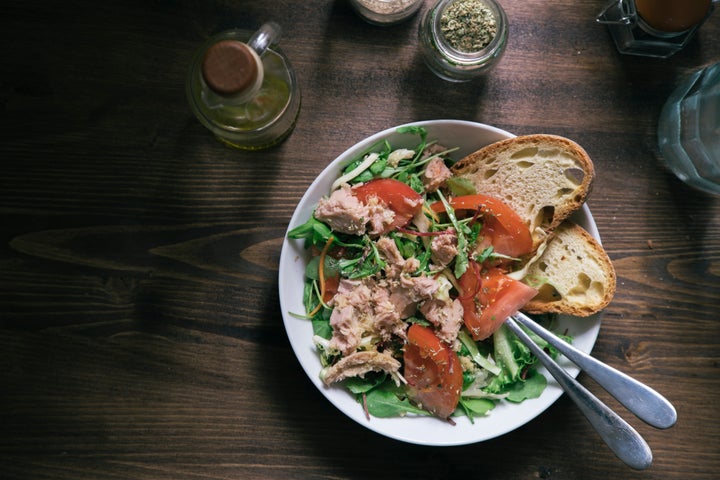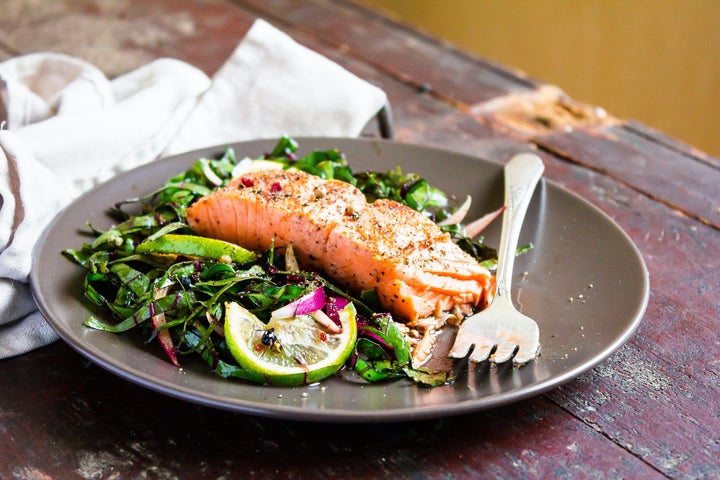
Pre-packaged salad kits are a boon to many a busy schedule. You’ve seen them in grocery stores, bagged up in the produce aisle, complete with lettuce, mix-ins and a packet of dressing.
They take the work out of washing, drying and chopping; the thought out of topping; and help people discover new favorite salad dressings and leafy greens. In combinations designed by serious research and development teams under the purview of big brand names and chefs like Zal Taleyarkhan, the corporate research chef for salad giant Fresh Express, they’re surefire, scientifically proven palate pleasers.
In testing, these teams “look at the flavor and texture nuances in the greens being used,” he told HuffPost. “We add heartier toppings, like parmesan crisps, when using a shredded kale base, but more delicate ones for a tender green leaf such as spinach to create a balanced salad kit.”
Yet there’s only so much they can do with the limitations imposed by shelf life, different humidity needs, the fragility of ingredients, and just straight-up macronutrient balance.
“I love salad kits! I always grab a few during my weekly grocery trip,” says registered dietitian Casey McCoy. “But the only problem is that, on their own, they usually don’t have enough inclusions to suffice for a satisfying meal.”
But they can.
With just a little more prep, produce and creativity, guided by the crafted flavors and materials provided in that bagged kit, it takes minimal effort to turn a bag of greens into a robust, delicious dinner. We’ll show you how.
Turn up the volume
Traditional salad kits tend to be pretty light and include way more dressing than you really need. So why not stretch it out, while bulking up the mix nutritionally and visually with a few other add-ins from the produce aisle?
Hearty, crunchy broccoli slaw is one of my favorite picks—it can stand up to vigorous tossing and forces slower, more mindful chewing to allow you time to register satiety. Coleslaw mix is another good one, and the basis of a lot of chopped salad kits, as it’s just green and red cabbage and shredded carrots. You can also save green while getting more greens out of one purchase by simply buying a head of cabbage, then cutting off what you need as you need it. Cabbage lasts longer whole, and you’d be surprised at how many cups just a few leaves can yield. Pre-shredded carrots are also inexpensive and will keep through many a round of salads.
Even simpler, make your salad bigger with voluminous greens. Spring mix, Romaine lettuce hearts, baby spinach, even chopped kale are great ways to amp up the nutritive value of your salad and help trick yourself into feeling like it’s a heavier, supersized entrée than it actually is. Because we eat first with our eyes, you might be surprised at how full you can feel when presented with a massive bowl of food to conquer.
Add protein and a carb
Salad kits are mostly roughage. You get a good dose of fats from the dressing, maybe from the included accents of nuts, seeds and cheese. You might get a few grams of carbs from toppings like croutons, pita slivers, tortilla strips or bagel chips. But ultimately, you need a good balance of all three macros — protein, carbohydrates and fat — for even the biggest bowl to be considered a great meal.

“I feel much more satisfied with a salad if I can include some additional carbs,” McCoy said. “I might make some garlic bread or a small flatbread pizza.” On the lighter side, accompany it with a nice whole-grain roll or a couple slices of wheat toast for protein, fiber and carbs. If you went with a cabbage-based kit and have fiber squared away for the day, treat yourself to a croissant or brioche roll, even.
Most importantly, pick a protein to round things out. “So many people tell me that they feel hungry an hour after eating a salad. My question is always, ‘Did you add protein?’” McCoy said. “Because protein plays a huge role in satisfaction and fullness. Salad kits often tend to include some types like seeds, nuts or cheese, but for me — and most people — it’s not enough.”
How to choose a protein
Consider the salad’s theme
The first thing you need to do is think about the cultural or regional flavor profile the salad company had in mind when they created the blend. “Some of our most popular salad kits fuse flavors from around the world with new, out-of-the-box ingredients,” Taleyarkahn says. This gives you a direction to start riffing in.
It can be as easy as simple word association; the clues are often right in the flavor name. For example, Southwestern Cheddar, Mediterranean Crunch, Italian Balsamic ― these all allude to a very specific type of cuisine, which should lead your mind to a natural accompaniment.
Stop and think, what’s the first food item you picture when you go to that kind of restaurant? Which ingredients in that dish are your favorites? From here, you can let your imagination run wild with the characteristic flavors as your guide.
Generic Eastern-inspired flavors (think “Asian sesame”) pair well with teriyaki baked tofu or chicken. More regional ones (think a Thai-inspired salad kit) work well by marinating chicken in a satay seasoning or pork in lemongrass, and grilling it as a topper.
Mexican-inspired blends can be topped with black beans, adobo-dusted grilled chicken, popcorn shrimp, or taco-seasoned turkey or ground beef crumbles. Maybe even roasted peppers and onions for good measure to make it a warm salad. Add in a bit of seasoned rice, top with a dollop of creamy, naturally high-protein Fage in lieu of sour cream, and you have yourself a burrito bowl-salad hybrid set to satisfy.
Neutralize the sweet ingredients with the right protein
Some salad kits aim to make their blends more palatable by leaning hard on sugar. Onion, poppy seed, tangerine, maple bourbon or dijon, honey pecan, fruity vinaigrettes, and the inclusion of dried cranberries or cherries are dead giveaways that this salad kit is going to taste more like a treat. But it’s hard to feel like you’re having a “real” dinner if the only flavor profile your brain is registering is sweet, which is where it’s up to you to bring in the savory.
Many popular kits try to balance out the sweetness with salty bacon, but the addition of simple salt-and-peppered grilled chicken breast most effectively bridges the two sides of the spectrum.
For salads that include apple, pear or other fruits, think about what savory counterparts you’ve enjoyed with those fruits. Apple, for example, is a natural accompaniment to lean pork loin or chops, which you can broil or grill simply as your leading protein. Nuts are stellar in the fruit-forward salads, from salty cashews to heart-healthy toasted walnuts.

Tone down brisk and bitter ingredients with fatty proteins
On the other side of that spectrum are chopped salad kits made with more mature and bitter greens. Those will be your blends with broccoli stalks, Brussels sprouts, radicchio, endives, kale and other harsher, tougher leaves. If you have a hard time with bitter flavors, counter them with some grilled shrimp, the natural sweet undertones of which will become more pronounced, and toss in some sweet cherry tomatoes.
Or steer into it. To enhance for flavor and digestion, boost a bitter salad with a bold and fatty protein like grilled or broiled salmon or steak. Taleyarkhan puts his chef’s hat back on for blends like these to add mozzarella pearls, prosciutto, pancetta and sun-dried tomatoes for Mediterranean and Italian-based kits. Easier still, grab a rotisserie chicken from your local supermarket deli or Costco, and carve that up for a mix-in. These tougher vegetables can handle a lot of tossing, and the juices from the chicken will make them even tastier and fuller-flavored. The richness of any of the above helps to take the edge off the vegetables.
Lentils are a good vegetarian option as well; their earthiness is a natural complement.
What are you waiting for?
It all goes back to sitting back and letting your gut instincts guide your stomach. The very first food you associate with any trigger word in the salad kit’s name is likely the best and right choice to turn your bag of greens into a dinner supreme.